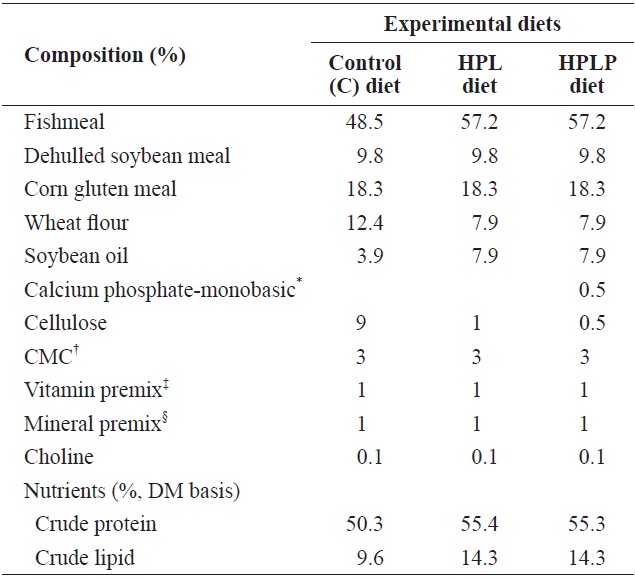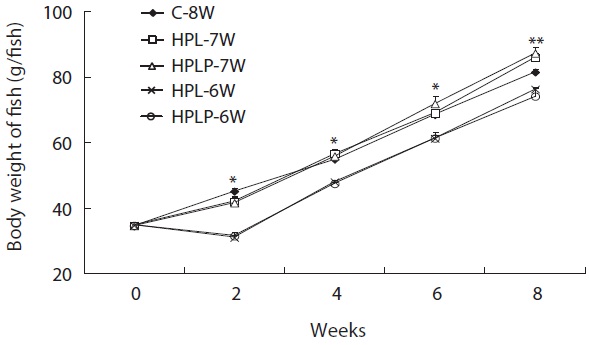



Compensatory growth of fish is rapid or faster than normal growth rate of fish resulting from refeeding after fasting or undernutrition. Compensatory growth of fish varies depending on fish species, fish size, water temperature, feed allowance, dietary nutrient content, duration of feeding trial and feeding regimes (Bilton and Robins, 1973; Rueda et al., 1998; Wang et al., 2000; Gaylord and Gatlin, 2001; Zhu et al., 2001; Cho, 2005; Cho et al., 2006; Oh et al., 2007, 2008; Bav?evi? et al., 2010).
In our earlier studies (Cho, 2005; Cho et al., 2006), juvenile olive flounder
Iba?ez et al. (2012) recently reported that food availability and type between different grow-out facilities resulted in compensatory growth of juvenile cyprinid roach
I hypothesized that the manipulation of dietary nutrient contents including phosphorous could affect compensatory growth of juvenile olive flounder.
>
Fish and experimental conditions
Juvenile olive flounder were purchased from a private hatchery and acclimated to the experimental conditions for 1 week. During the acclimation period, fish were hand-fed with the commercial feed twice a day. Thirty fish (initial body weight of fish 34.8 g) per tank were randomly chosen and distributed into 15 flow-through 180-L tanks (water volume 150 L). The water source was the sand-filtered natural seawater and aeration supplied to each tank. The flow rate of water into each tank was 10 L/min. Water temperature ranged from 18.5℃ to 23.6℃ (mean ± SD, 22.4 ± 1.05℃) and photoperiod was left in a natural condition.
>
Preparation of the experimental diets
Three experimental diets were prepared (Table 1): the control (C) diet, high protein and lipid (HPL) diet, and HPL diet with supplementation of calcium phosphate-monobasic (HPLP). The C diet was prepared to satisfy dietary nutrient requirements of olive flounder (Lee et al., 2000, 2002). Additionally, the HPL diet was prepared by an increase of fishmeal and soybean oil instead of wheat flour and cellulose. The HPLP diet was prepared by an inclusion of 0.5% calcium phosphate-monobasic into the HPL diet instead of cellulose.
Fishmeal, soybean meal and corn gluten meal, and soybean oil were used as the protein and lipid sources, respectively. Ingredients of the experimental diets were well mixed with water at a 7:3 ratio and pelletized by a pellet-extruder. The experimental diets were dried overnight at room temperature and stored at ?20℃ until use.
Five treatments were prepared in triplicate: fish were handfed daily with the C diet twice a day (09:00 and 17:00), 7 days a week, for 8 weeks (C-8W) were designated as a control group; fish starved for 1 week, and then fed with the HPL or HPLP diets twice a day, 7 days a week, for 7 weeks were referred to as HPL-7W and HPLP-7W, respectively; and fish starved for 2 weeks, and then fed with the HPL or HPLP diets twice a day, 7 days a week, for 6 weeks were referred to as HPL-6W and HPLP-6W, respectively. Fish were weighed collectively from each tank in bi-weekly intervals throughout the 8-week trial.
One-way ANOVA and Duncan’s multiple range test (Duncan, 1955) were used to analyze the significance of the differences among the means of treatments by using SAS program version 9.3 (SAS Institute, Cary, NC, USA).
Survival of juvenile olive flounder ranged from 91.1% to 97.8% and was not significantly (
No difference in body weight of juvenile olive flounder was
[Table 1.] Chemical composition of the experimental diets (%, DM basis)

Chemical composition of the experimental diets (%, DM basis)
found at the beginning of the trial: however, fish body weight with C-8W, HPL-7W and HPLP-7W treatments was significantly (
However, in this study, a slight, but not significant improvement in compensatory growth of fish with HPLP-7W treatment as compared to fish with HPL-7W treatment was observed (Fig. 1), indicating a dietary inclusion of phosphorous

Performance and biological index of juvenile olive flounder Paralichthys olivaceus fed the experimental diets with different feeding regime
had no distinctive effect on compensatory growth of fish. In addition, since dietary supplementation of phosphorous can result in a deterioration of water quality, phosphorus supplementation must be carefully considered a practical application on a fish farm. Turano et al. (2008) also reported that soluble reactive phosphorous was 41% and 24% lower in ponds with a cycled 3-week feeding after a 3-week feed deprivation and 3-week feeding after a 6-week feed deprivation, respectively, than in ponds with daily satiation feeding for 18 weeks.
Overcompensation of fish, as compared to fish in a control group (no feed deprivation) was observed in only a few studies. Hayward et al. (1997) reported that hybrid sunfish (
Full compensation was not achieved in fish subjected to a 2-week feed deprivation (HPL-6W and HPLP-6W treatments) in this study. This result contradicts Cho and Heo’s (2011) study showing that juvenile olive flounder fed a 55% protein diet with 14% lipid for 6 weeks after a 2-week feed deprivation could reach full compensatory growth in the 8-week trial or Cho (2005) and Cho et al.’s (2006) studies showing that juvenile olive flounder were able to reach full compensatory growth up to the 2-week feed deprivation in the 8-week trials. Gaylord and Gatlin (2001) also reported that cumulative weight gain was increased in catfish fed the diets containing 37% crude protein, as compared to fish fed 32% protein when fish were fed to satiation for 6 weeks or 11 days of feeding after a 3-day feed deprivation in three cycles.
Hyperphagia is a common phenomenon explaining compensation of fish. Fish exhibited hyperphagia in many studies (Rueda et al., 1998; Wang et al., 2000; Zhu et al., 2004; Cho, 2005; Cho et al., 2006; Cho and Heo, 2011) showing full compensation of fish subjected to feed deprivation for a certain period of time. However, overall feed intake by fish was proportional to the weeks of feeding in this study. This could explain why fish in the 2-week feed deprivation groups (HPL- 6W and HPLP-6W treatments) did not achieve full compensation, as compared to fish with C-8W treatment.
Feed conversion ratio (FCR) of olive flounder with HPLP- 7W, HPL-6W and HPLP-6W treatments was significantly (
Condition factor (CF) of olive flounder with HPL-6W and HPLP-6W treatments was significantly (
Hepatosomatic index (HSI) is a good index to indicate compensatory growth of fish (Gaylord and Gatlin, 2000; Cho, 2005). Bav?evi? et al. (2010) showed that gilthead sea bream
When considering the present results, dietary supplementation of protein and lipid resulted in overcompensation of juvenile olive flounder subjected to a 1-week feed deprivation, but not a 2-week feed deprivation. In addition, dietary supplementation of phosphorous did not further improve compensatory growth of fish.


